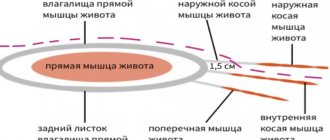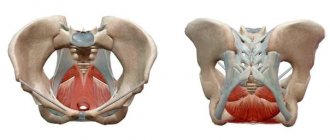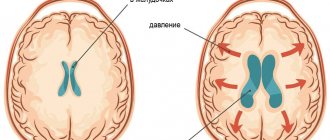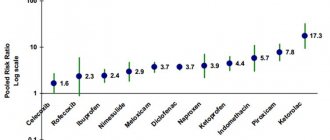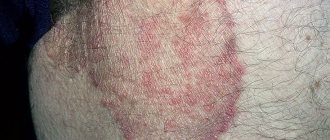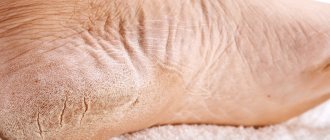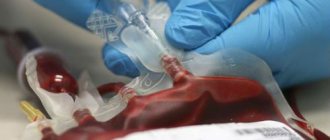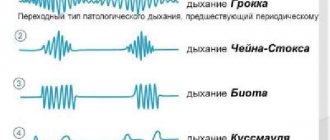Diagnosis of hernias
The diagnosis in most cases can be made based on a simple examination of the patient, when a protrusion is detected in typical places, increasing with physical activity. In unclear cases, the surgeon may use additional research methods.
- Ultrasound of a hernia allows you to determine the size of the hernial orifice, distinguish small irreducible hernias from soft tissue benign tumors of the subcutaneous fatty tissue (for example, lipomas), and enlarged lymph nodes of the groin area. It is especially useful for inguinal hernias.
- Herniography is used in case of unclear pain in the groin area (to exclude an externally invisible inguinal or femoral hernia), perineum (to exclude a perineal hernia) and in case of an inguinal hernia, if there is doubt about the presence of a hernia on the opposite side.
- Computed tomography allows you to clearly determine the nature and size of the abdominal wall defect.
In recent years, due to the widespread introduction of new technologies and the latest scientific achievements and the use of modern plastic and suture materials, the quality of hernia repairs has significantly improved, and the number of relapses and postoperative complications has decreased.
An umbilical hernia is a pathological protrusion of abdominal organs through the umbilical ring, which can disappear or significantly decrease in size when the body is horizontal. This disease affects 6–10% of the population in adults and is more common in women.
Symptoms
The severity of symptoms of an umbilical hernia depends on many factors:
- its size;
- the presence of adhesions in the abdominal cavity;
- the presence or absence of strangulation of the hernial sac;
- general condition of the patient.
The very first symptom of a hernia is the appearance of a small protrusion in the navel area. There may not be any pain at first. At an early stage, you can even repair the hernia yourself, without a doctor. If adhesions appear, it will no longer be possible to straighten it. The duration of the process of adhesions formation varies from person to person, so some people have been accustomed for years to repair a hernia and move on without seeing a doctor, while for others, adhesions appear quite quickly.
Pain is not always present with an umbilical hernia in adults. It can appear during physical activity, coughing and standing in one place for a long time. Late stages may already be accompanied by nausea, vomiting, belching, constipation and difficulty urinating.
Treatment
The only treatment for umbilical hernia in adults is surgery. Surgery for an umbilical hernia may be postponed in uncomplicated forms of the disease in pregnant women or in cases of concomitant diseases aggravating the general condition of the patient (acute or aggravated chronic diseases, pulmonary or heart failure, etc.).
Specialists
| 5.0 505 reviews | Mikhailenko Anatoly Nikolaevich Mammologist 40 years of experience Doctor of the highest category Admission from 2500 rub. |
| 4.9 89 reviews | Tokin Sergey Alexandrovich Mammologist Experience 34 years Doctor of the highest category Admission from 2500 rub. |
| 4.2 65 reviews | Andrianova Irina Mikhailovna Mammologist Experience 35 years Doctor of the highest category Admission from 2500 rub. |
Inguinal hernia
Classification
According to anatomical features, oblique, direct and combined inguinal hernias are distinguished. Indirect inguinal hernias can be of congenital or acquired origin.
Direct inguinal hernias are always acquired and are characterized by protrusion of the peritoneum into the inguinal canal directly through the inguinal space, outside the spermatic cord. Combined inguinal hernias are complex formations consisting of several hernial sacs that do not communicate with each other and exit through different hernial openings.
There are also reducible inguinal hernias (which can appear and disappear) and irreducible ones, the independent elimination of which is impossible due to the adhesion of the hernial sac to the hernial contents. A sliding inguinal hernia is said to exist if the hernial sac is formed not only by the parietal peritoneum, but also by its visceral layer covering the sliding organ. A sliding inguinal hernia may include the bladder wall, cecum, ovaries, tubes, uterus, etc.
If the inguinal hernia returns again after surgery, then it is regarded as recurrent.
According to the clinical course, uncomplicated and complicated inguinal hernias are distinguished.
- Non-strangulated inguinal hernia;
- Strangulated inguinal hernia.
With a strangulated inguinal hernia, the following clinical picture is observed:
- sudden onset;
- irreducibility;
- sharp, gradually increasing pain;
- nausea, hiccups, repeated painful vomiting;
- retention of stool and gases;
- serious condition of the patient;
- tension, pain of hernial protrusion.
The presence of these clinical symptoms is an indication for emergency surgery.
Symptoms of inguinal hernia
- Volumetric formations appear at the site of the hernial protrusion. Its sizes can be different - from a walnut to a chicken egg. A hernial protrusion can occur periodically and be easily reduced inwards - spontaneously or by the patient (reducible hernia), or it can be present constantly (irreducible hernia).
- The patient begins to complain of periodic pain in the hernia area, which intensifies with physical activity and can radiate to the scrotum, sacrum, lower back and lower abdomen. Over time, the pain becomes chronic and quite severe.
- There is a feeling of discomfort when walking.
Diagnostics
When examining patients with inguinal hernias, both groin areas are examined in a standing and lying position to identify (in unclear cases) asymmetry, even subtle, but giving some indication of the possible presence of a hernia.
Palpation of the superficial inguinal ring with insertion of a finger and simultaneous tension of the abdominal wall (coughing) gives a “shock symptom.”
Examination of the superficial inguinal ring in women is much more difficult than in men, and is possible only with loose skin and a significant expansion of the superficial inguinal ring.
Treatment of inguinal hernia
Treatment of inguinal hernias involves surgical removal of the defect in the abdominal wall. Closing the hernial defect and restoring the integrity of the abdominal wall can be done using local tissues - aponeurosis (hernioplasty with one’s own tissues) or a synthetic prosthesis (hernioplasty with the installation of a mesh prosthesis). Today, tension-free methods of inguinal hernia repair using a mesh graft are increasingly used in surgery. In this case, the hernial orifice is strengthened from the inside with a special polypropylene mesh, which subsequently serves as a frame for the germination of connective tissue and prevents the exit of internal organs. Tension-free hernioplasty reduces the likelihood of recurrence of an inguinal hernia. Treatment of inguinal hernias can be performed laparoscopically.
Forecast and prevention of inguinal hernias
In the long term, recurrence of the inguinal hernia is possible. Relapses develop especially often after tension hernioplasty. In other cases, the prognosis for work ability and quality of life is favorable.
The goals of preventing an inguinal hernia include strengthening the muscles of the abdominal wall, combating constipation, quitting smoking, which leads to coughing, weight control, and wearing a bandage during pregnancy.
Hernia of the white line
A hernia of the linea alba appears as a painful protrusion anywhere along the midline of the abdomen.
Hernia of the white line of the abdomen (also known as preperitoneal lipoma) is a condition in which gaps form in the tendon fibers between the muscles along the midline of the abdomen, through which first the fat and then the abdominal organs emerge.
Conservative treatment
Removal of this type of hernia is possible when it is necessary to relieve the patient from complications. Thus, the pathology stops growing, and the symptoms become less severe. This type is suitable only for those patients who are contraindicated for surgery due to age, another disease, or pregnant women.
The following measures are being taken:
- treatment with medications;
- combating the causes that provoke pressure inside the womb;
- diet food;
- special gymnastics;
- indication for wearing a bandage;
- special massage.
Symptoms of hernia of the white line of the abdomen:
- painful protrusion of the midline of the abdomen, often in the upper parts;
- pain in the upper abdomen, especially with straining and sudden movements;
- muscle separation (diastasis) along the midline of the abdomen;
- nausea, sometimes vomiting.
Depending on the location relative to the navel, the following hernias of the white line of the abdomen are distinguished:
- supra-umbilical - above the navel;
- peri-umbilical - next to the umbilical ring;
- subumbilical - below the navel.
In some cases, hernias of the white line of the abdomen do not manifest themselves in any way and are discovered by chance.
Emergency care is required if an umbilical hernia is strangulated and the following symptoms appear:
- rapidly increasing abdominal pain;
- nausea, vomiting;
- if the hernia does not reduce with light pressure while lying on your back;
- the presence of blood in the stool, the absence of bowel movements and the passage of gases.
Prevention of hernia of the white line of the abdomen:
- do not lift objects that are too heavy.
- abdominal muscle training;
- wearing a bandage during pregnancy;
- proper nutrition;
- Use proper lifting technique.
Treatment of hernia of the white line of the abdomen
You can only get rid of a hernia surgically in a hospital setting.
Types of operations (hernioplasty):
- Plastic surgery with local tissues - suturing the defect of the white line of the abdomen with the elimination of possible diastasis of the rectus muscles. However, due to the weakness of the connective tissue and the significant load on the sutures after surgery, relapses (re-formation of a hernia) occur in 20-40% of cases.
- Plastic surgery with the use of synthetic prostheses - installation of a mesh to close the aponeurosis defect after eliminating diastasis of the rectus muscles due to hernia of the white line of the abdomen. The chance of relapse is very low. The operation is performed under anesthesia.
A feature of the surgical treatment of hernias of the white line of the abdomen is that eliminating the hernia alone is not enough. It is also necessary to eliminate diastasis of the rectus abdominis muscles.
Spigelian line hernia
Spigelian line hernia is a lateral hernia of the abdomen that emerges through a gap in the aponeurosis of the abdominal wall along the lateral edge of the rectus abdominis muscle.
Experts record this pathology with equal frequency in representatives of both sexes. In clinical practice it is quite rare.
Diagnostics. The presence of a hernial protrusion and a defect in the aponeurosis along the line connecting the umbilicus to the anterior superior iliac spine gives grounds to diagnose a hernia of the Spigelian line. Existing pain in the hernia area intensifies with physical stress and decreases in a horizontal position. Due to the narrow hernial orifice, strangulation of the Spigelian line hernia very often occurs.
Treatment is surgical. To access the hernial sac and isolate it, various incisions are used: oblique, pararectal, transverse. The hernial sac is isolated and processed according to general rules. The stump of the hernial sac is immersed under the operative fascia. The edges of the muscles and aponeurosis are sutured.
Postoperative hernias
Postoperative hernia is a condition in which the abdominal organs (intestines, greater omentum) extend beyond the abdominal wall in the area of the scar formed after surgery.
Symptoms of postoperative hernia
- painful protrusion in the area of the postoperative scar;
- abdominal pain, especially with straining and sudden movements;
- nausea, sometimes vomiting.
Course of postoperative hernia
Postoperative hernias in the early stages are reducible and are not accompanied by pain. However, with sudden straining, falling, or lifting heavy objects, pain appears and the protrusion increases. As the hernia progresses, the pain intensifies, becoming cramping in nature. At the same time, intestinal lethargy, constipation, flatulence, and nausea develop; The activity of patients sharply decreases, fecal stagnation, accompanied by intoxication, is periodically observed.
Causes of postoperative hernia
A postoperative hernia is a consequence of a previously performed surgical intervention. The determining reasons for its development are:
- suppuration, inflammation of the surgical suture;
- increased physical activity after surgery;
- violation of the bandage wearing regime in the postoperative period;
- insufficient restorative forces and low immunity;
- obesity;
- severe cough, vomiting, constipation in the postoperative period;
- surgical errors made during the first operation.
Prevention of postoperative hernias
- wearing a bandage after abdominal surgery;
- proper nutrition;
- weight normalization;
- limitation of physical activity in the postoperative period.
Treatment of postoperative hernia
The only way to get rid of a postoperative hernia is surgery. Types of operations (hernioplasty):
- Plastic surgery with local tissues - suturing of the aponeurosis defect of the anterior abdominal wall. Plastic surgery with local tissues is possible only if the defect size is small - less than 5 cm. When eliminating small postoperative hernias, local anesthesia is acceptable; in other situations, the operation is performed under anesthesia.
- Plastic surgery with the use of synthetic prostheses - covering the aponeurosis defect with a postoperative hernia with a synthetic prosthesis. There are various methods, characterized by different locations of the mesh in the anatomical structures of the anterior abdominal wall. The chance of relapse is very low. The operation is performed under anesthesia.
Risk factors
A hernia of the spine or abdomen is the most common variant of this disease. And there are certain groups of people who fall under a special risk factor:
- loaders and people whose profession involves constant lifting of heavy objects (hernia of the spine and lumbar region);
- overweight people (both abdominal hernia and intervertebral hernia are possible)
- pregnant women (both hernia of the spine and lumbar region and abdominal hernia can occur).
But it should be understood that no one is immune from this disease.
